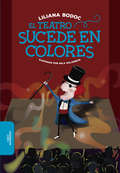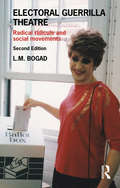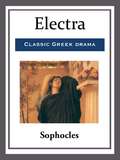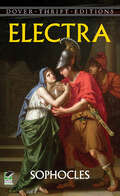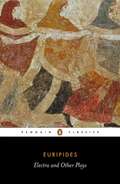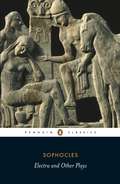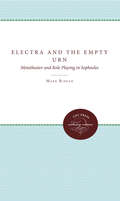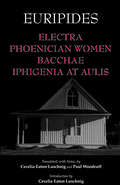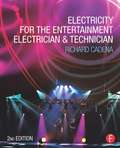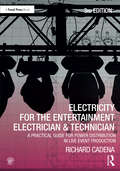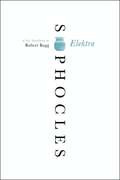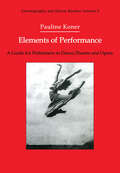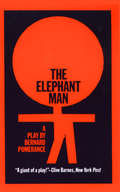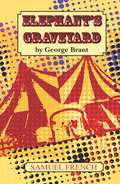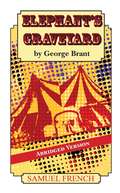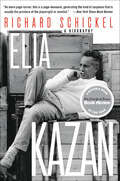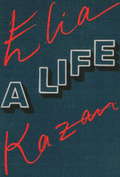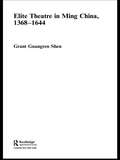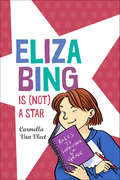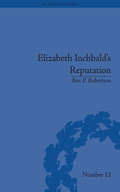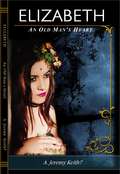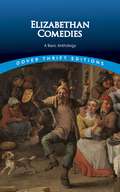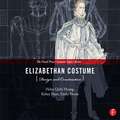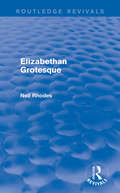- Table View
- List View
El teatro sucede en colores (Alfaguara Vuelve A Las Escuelas Ser.)
by Liliana BodocVersión teatral del libro Sucedió en colores. Cinco actos que nos conectan con las emociones y sentimientos profundos. Ideales para leer; disfrutar y también para representar en su versión de teatro. El libro es una invitación a leer teatro y a representar una pieza teatral. Inicia con una introducción "El teatro no es cuento"; que acerca a los lectores a la versión teatral de Sucedió en colores. En el acto ROJO; un diablo se enamora de la más hermosa de las vendedoras de manzanas del Mercado de las Rosas. Pero para que su amor se concrete tendrá que recibir por respuesta solo tres "Sí" de la encantadora muchacha. "Solo tres Sí"; ni una palabra más; ni una menos. En BLANCO; a la hora de los cuentos; un abuelo esquimal relata historias a sus nietos. Y la noche se llena de luna; luna del oso; luna entera; luna de lobo y luna muerta. Porque así es como se suceden las lunas en el cielo. Y luego se suceden tres relatos más; cada uno teñido de un color y de emociones intensas. Así se van sucediendo los colores, negro; amarillo y verde hasta conformar una pieza sensible y con personajes entrañables. Cada acto va creando un universo de juego; potencia la imaginación y la fantasía.
Electoral Guerrilla Theatre: Radical Ridicule and Social Movements
by L.M. BogadPraise for the First Edition: 'A major contribution to performance studies. If cynicism and political quietism have quelled your impulse to rage against this sorry state of affairs, Bogad demonstrates, with wit and verve, that it is possible to expose the sham and, through a variety of performative tactics, make a meaningful contribution to democracy.' Modern Drama 'A compelling and urgent read. Bogad’s passion for the topic reminds the reader of the exhilaration of live performance and the importance of engagement in democratic life.' Theatre Journal 'Delightfully written and wonderfully provocative ... Valuable reading for any scholar of social movements.' Mobilization 'As a guide to both theory and action, it is insightful, entertaining and indispensable.' Andrew Boyd, Wrangler-in-Chief, Beautiful Trouble 'Beautifully contextualized within social movement theory, this book enlivens the debate about performative interventions into power.'Jan Cohen-Cruz, Editor, Public, A Journal of Imagining America 'Electoral Guerrilla Theatre deals a refreshing wild card in the repertoire of resistance.' Baz Kershaw, Emeritus Professor, University of Warwick, and author of The Radical In Performance. In liberal democracies across the globe, where the right to vote is framed as both civil right and civic duty, disillusioned creative activists run for public office on satiric, ironic and iconoclastic platforms. With little intention of "winning" in the conventional sense, they use drag, camp and stand-up comedy to undermine the legitimacy of their opponents and sometimes the electoral system itself. This revised and updated edition of Electoral Guerrilla Theatre explores the phenomenon of the satirical election campaign, and questions the purpose of such public political performances. Drawing on extensive archival and ethnographic research, this is an entertaining and illuminating read that will be invaluable to students and scholars working across a variety of disciplines, including performance studies, the social sciences, cultural studies and politics. New case studies for this edition include: Reverend Billy’s run for Mayor of New York City in 2009; Stephen Colbert’s run for President in 2012; Candidates including Superbarrio, the Best Party, Antanas Mockus, and Einstein the Dog.
Electra
by SophoclesSet in the city of Argos a few years after the Trojan war, 'Electra' recounts the tale of Electra and the vengeance that she and her brother Orestes take on their mother Clytemnestra and step father Aegisthus for the murder of their father, Agamemnon.
Electra
by SophoclesMasterpiece of drama concerns the revenge Electra takes on her mother for the murder of her father. One of the best-known heroines of all drama and a towering figure of Greek tragedy.
Electra and Other Plays
by EuripidesWritten during the fierce struggle for supremacy between Sparta and Euripides' native Athens, these five plays are haunted by the shadow of war - and in particular its impact on women. In Electra, the children of Agamemnon take bloody revenge on their mother for murdering their father after his return from Troy, and Suppliant Women depicts the grieving mothers of those killed in battle. The other plays deal with the aftermath of the Trojan War for the defeated survivors, as Andromache shows Hector's widow as a trophy of war in the house of her Greek captor, and Hecabe portrays a defeated queen avenging the murder of her last-remaining son, while Trojan Women tells of the plight of the city's women in the hands of the victors. Translated by John Davie and with an introduction and notes by Richard Rutherford
Electra and Other Plays: Ajax, Women Of Trachis, Electra, And Philoctetes
by SophoclesSophocles’ innovative plays transformed Greek myths into dramas featuring complex human characters, through which he explored profound moral issues. Electra portrays the grief of a young woman for her father Agamemnon, who has been killed by her mother’s lover. Aeschylus and Euripides also dramatized this story, but the objectivity and humanity of Sophocles’ version provides a new perspective. Depicting the fall of a great hero, Ajax examines the enigma of power and weakness combined in one being, while the Women of Trachis portrays the tragic love and error of Heracles’ deserted wife Deianeira, and Philoctetes deals with the conflict between physical force and moral strength.
Electra and the Empty Urn: Metatheater and Role Playing in Sophocles
by Mark RingerMetatheater, or "theater within theater," is a critical approach often used in studies of Shakespearian or modern drama. Breaking new ground in the study of ancient Greek tragedy, Mark Ringer applies the concept of metatheatricality to the work of Sophocles. His innovative analysis sheds light on Sophocles' technical ingenuity and reveals previously unrecognized facets of fifth-century performative irony. Ringer analyzes the layers of theatrical self-awareness in all sevenSophoclean tragedies, giving special attention to Electra, theplaywright's most metatheatrical work. He focuses on plays within plays,characters who appear to be in rivalry with their playwright in "scripting"their dramas, and the various roles that characters assume in their attempts to deceive other characters or even themselves. Ringer also examines instances of literal role playing, exploring the implications of the Greek convention of sharing multiple roles among only three actors.Sophocles has long been praised as one of the masters of dramaticirony. Awareness of Sophoclean metatheater, Ringer shows, deepens our appreciation of that irony and reveals the playwright's keen awareness of his art.Originally published in 1998.A UNC Press Enduring Edition -- UNC Press Enduring Editions use the latest in digital technology to make available again books from our distinguished backlist that were previously out of print. These editions are published unaltered from the original, and are presented in affordable paperback formats, bringing readers both historical and cultural value.
Electra, Phoenician Women, Bacchae, and Iphigenia at Aulis
by Euripides Paul Woodruff Cecelia Eaton LuschnigThe four late plays of Euripides collected here, in beautifully crafted translations by Cecelia Eaton Luschnig and Paul Woodruff, offer a faithful and dynamic representation of the playwright’s mature vision.
Electricity for the Entertainment Electrician & Technician
by Richard CadenaThe application of electricity for the theatre or a concert stage is not the same as for a residence or commercial building. Electricity for the Entertainment Electrician & Technician provides you with the fundamentals of theory of electricity as well as the latest guidelines and tips for how to stay safe, current and meet the needs of the entertainment industry. Written by an ETCP (Entertainment Technician Certification Program) trainer this reference supports practicing technicians and provides new technicians the assistance needed for a successful career in the entertainment industry. * The only reference on electricity for the entertainment industry professional!* Written by an ETCP (Entertainment Technician Certification Program) trainer and seasoned professional* Free additional practice problems and animations at www.electricityentertainmenttech.com
Electricity for the Entertainment Electrician & Technician: A Practical Guide for Power Distribution in Live Event Production
by Richard CadenaNow in its third edition, Electricity for the Entertainment Electrician & Technician is a comprehensive, practical study guide for aspiring and working professionals in live event production. The book covers every aspect of power distribution from the fundamentals, like basic circuits, to 3-phase power, power calculations, grounding and bonding, electrical safety, portable power generators, and battery power. With ample photographs and illustrations, practice problems and solutions, and real-world examples from experience and first-hand accounts, it provides readers with the knowledge to safely design, set up, and monitor power distribution systems. The third edition expands on grounding and bonding, portable power generators, balanced and unbalanced 3-phase power calculations, battery power, and more. The last chapter walks readers through the process of prepping for a show, setting up a portable power distribution system, and monitoring every aspect of the system, including voltage, current, and heat using an infrared camera, explaining in detail best practices and the logic behind them. Covering topics that are listed in the content outline for the ETCP Entertainment Electrician Certification exam as well as the ETCP Portable Power Distribution Technician Certification exam, this reference supports practicing technicians and provides new technicians the assistance they need for a successful career in the entertainment industry. Additional resources, including conversion tables, voltage spreadsheets, articles from Lighting & Sound International, Lighting & Sound America, and Protocol, and animations and illustrations depicting electricity and electric power distribution developed for the author’s workshops, can be found on the companion website www.electrics.tech.
Electricity for the Entertainment Electrician & Technician: A Practical Guide for Power Distribution in Live Event Production
by Richard CadenaNow in its third edition, Electricity for the Entertainment Electrician & Technician is a comprehensive, practical study guide for aspiring and working professionals in live event production.The book covers every aspect of power distribution from the fundamentals, like basic circuits, to 3-phase power, power calculations, grounding and bonding, electrical safety, portable power generators, and battery power. With ample photographs and illustrations, practice problems and solutions, and real-world examples from experience and first-hand accounts, it provides readers with the knowledge to safely design, set up, and monitor power distribution systems. The third edition expands on grounding and bonding, portable power generators, balanced and unbalanced 3-phase power calculations, battery power, and more. The last chapter walks readers through the process of prepping for a show, setting up a portable power distribution system, and monitoring every aspect of the system, including voltage, current, and heat using an infrared camera, explaining in detail best practices and the logic behind them.Covering topics that are listed in the content outline for the ETCP Entertainment Electrician Certification exam as well as the ETCP Portable Power Distribution Technician Certification exam, this reference supports practicing technicians and provides new technicians the assistance they need for a successful career in the entertainment industry.Additional resources, including conversion tables, voltage spreadsheets, articles from Lighting & Sound International, Lighting & Sound America, and Protocol, and animations and illustrations depicting electricity and electric power distribution developed for the author’s workshops, can be found on the companion website www.electrics.tech.
Elektra
by SophoclesAmong the most celebrated plays of ancient Athens, Elektra is one of seven surviving dramas by the great Greek playwright, Sophocles, now available from Harper Perennial in a vivid and dynamic new translation by award-winning poet Robert Bagg. Elektra masterfully explores the consequences of revenge—both for those who bear the brunt of violence and for those who become obsessed by hatred under its influence—as it focuses on the cycle of bloodshed that consumes a royal family. This is Sophocles, vibrant and alive, for a new generation.
Elements of Performance: A Guide for Performers in Dance, Theatre and Opera (Choreography and Dance Studies Series)
by Pauline KonerFirst Published in 1992. Routledge is an imprint of Taylor & Francis, an informa company.
Elephant Man: A Play (Books That Changed the World)
by Bernard Pomerance&“An enthralling and luminous play&” about the nineteenth-century man whose physical deformity doomed him to the life of an outcast: &“haunting [and] splendid&” (The New York Times). The Elephant Man is based on the life of John Merrick, who lived in London during the latter part of the nineteenth century. A horribly deformed young man, a freak attraction in traveling side shows, is found abandoned and helpless and is admitted for observation to Whitechapel, a prestigious London hospital. Under the care of a famous young doctor who educates him and introduces him to London society, Merrick changes from a sensational object of pity to the urbane and witty favorite of the aristocracy and literati. But his belief that he can become a man like any other is a dream never to be realized. After premiering in London, The Elephant Man went on to Broadway where it won the Tony for Best Play in 1979. It was later revived in a Broadway production starring Bradley Cooper. &“TheElephant Man is a moving drama. Lofted on poetic wings, it nests on the human heart.&” —Time Magazine
Elephant's Graveyard
by George BrantWinner of the 2008 Keene Prize for Literature Winner of the 2008 David Mark Cohen National Playwriting Award Characters: 10m, 3f, flexible casting (Roles may be played by any race or gender except when specified.) / Drama Elephant's Graveyard is the true tale of the tragic collision of a struggling circus and a tiny town in Tennessee, which resulted in the only known lynching of an elephant. Set in September of 1916, the play combines historical fact and legend, exploring the deep-seated American craving for spectacle, violence and revenge. "The script-based on a true story about a traveling circus that, in 1916, stumbled into gory disaster in a muddy Tennessee town-is, like the best art, microscopically specific with echoes that radiate outward across time. It conjures a world with its own atmosphere and terrible internal logic. It's mesmerizing... symphonic in its emotional variations on a tragic theme. Elephant's Graveyard buzzes with truth about the consequences of misunderstanding, the invisible but enormous gap between artists and their audiences, and the infernal beauty of vaudeville." -The Stranger, Seattle "A theatrical masterpiece." - Columbia City Paper "The most striking production in the (NSDF) festival." - Times of London "Deeply moving...has the audience in stitches at the open and tears at the close." - TheSunCoast.com
Elephant’s Graveyard – Abridged Version
by George BrantDrama / 10m, 3f -casting may vary / Simple Set Winner of the 2008 Keene Prize for Literature Winner of the 2008 David Mark Cohen National Playwriting Award Elephant's Graveyard is the true tale of the tragic collision of a struggling circus and a tiny town in Tennessee, which resulted in the only known lynching of an elephant. Set in September of 1916, the play combines historical fact and legend, exploring the deep-seated American craving for spectacle, violence and revenge. This abridged version, which runs about 40 minutes in length, is perfect for high schools looking to perform the play at theatre competitions or for producers looking for a shorter version of the original script. Adapted by the author, it maintains the haunting drama of the award-winning full length play. "The script is, like the best art, microscopically specific with echoes that radiate outward across time. Elephant's Graveyard buzzes with truth about the consequences of misunderstanding, the invisible but enormous gap between artists and their audiences, and the infernal beauty of vaudeville." -The Stranger, Seattle "A theatrical masterpiece." -Columbia City Paper "The most striking production in the (NSDF) festival." -Times of London "Deeply moving...has the audience in stitches at the open and tears at the close." -TheSunCoast.com
Elia Kazan: A Biography
by Richard Schickel“No mere page-turner, this is a page-devourer, generating the kind of suspense that is usually the province of the playwright or novelist.” —The New York Times Book ReviewFew figures in film and theater history tower like Elia Kazan. Born in 1909 to Greek parents in Istanbul, Turkey, he arrived in America with incomparable vision and drive, and by the 1950s he was the most important and influential director in the nation, simultaneously dominating both theater and film. His productions of A Streetcar Named Desire and Death of a Salesman reshaped the values of the stage. His films—most notably On the Waterfront—brought a new realism and a new intensity of performance to the movies. Kazan’s career spanned times of enormous change in his adopted country, and his work affiliated him with many of America’s great artistic moments and figures, from New York City’s Group Theatre of the 1930s to the rebellious forefront of 1950s Hollywood; from Katharine Hepburn and Spencer Tracy to Marlon Brando and James Dean.Ebullient and secretive, bold and self-doubting, beloved yet reviled for “naming names” before the House Un-American Activities Committee, Kazan was an individual as complex and fascinating as any he directed. Noted film historian and critic Richard Schickel illuminates much more than a single astonishing life and life’s work: He pays discerning tribute to the power of theater and film, and casts a new light on six crucial decades of American history.Includes photographsA New York Times Notable Book“Magnificent.” —The Washington Post“Unsparingly thorough.” —Publishers Weekly“Remarkably insightful.” —Martin Scorsese“Vividly conveys the director’s potent personality: his exuberance, relentless work ethic, and frank assessments of the fleeting nature of fame.” —Booklist (starred review)
Elia Kazan: A Life
by Elia Kazan"This is the best autobiography I've read by a prominent American in I don't know how many years. It is endlessly absorbing and I believe this is because it concerns a man who is looking to find a coherent philosophy that will be tough enough to contain all that is ugly in his person and his experience, yet shall prove sufficiently compassionate to give honest judgment on himself and others. Somehow, the author brings this off. Elia Kazan: A Life has that candor of confession which is possible only when the deepest wounds have healed and honesty can achieve what honesty so rarely arrives at--a rich and hearty flavor. By such means, a famous director has written a book that offers the kind of human wealth we find in a major novel." --Norman Mailer. In this amazing autobiography, Kazan at seventy-eight brings to the undiluted telling of his story--and revelation of himself--all the passion, vitality, and truth, the almost outrageous honesty, that have made him so formidable a stage director (A Streetcar Named Desire, Death of a Salesman, All My Sons, Cat on a Hot Tin Roof, Tea and Sympathy), film director (On the Waterfront, East of Eden, Gentleman's Agreement, Splendor in the Grass, Baby Doll, The Last Tycoon, A Face in the Crowd), and novelist (the number-one best-seller The Arrangement.) Kazan gives us his sense of himself as an outsider (a Greek rug merchant's son born in Turkey, an immigrant's son raised in New York and educated at Williams College). He takes us into the almost accidental sojourn at the Yale Drama School that triggered his commitment to theatre, and his edgy, exciting apprenticeship with the new and astonishing Group Theatre, as stagehand and stage manager--and as actor (Waiting for Lefty, Golden Boy) ... his first nervous and then successful attempts at directing for theatre and movies (The Skin of Our Teeth, A Tree Grows in Brooklyn) ... his return to New York to co-found the Actors Studio (and his long and ambivalent relationship with Lee Strasberg) ... his emergence as premier director on both coasts. With his director's eye for the telling scene, Kazan shares the joys and complications of production, his unique insights on acting, directing, and producing. He makes us feel the close presence of the actors, producers, and writers he's worked with--James Dean, Marlon Brando, Tennessee Williams, Vivien Leigh, Tallulah Bankhead, Sam Spiegel, Darryl Zanuck, Harold Clurman, Arthur Miller, Budd Schulberg, James Baldwin, Clifford Odets, and John Steinbeck among them. He gives us a frank and affectionate portrait of Marilyn Monroe. He talks with startling candor about himself as husband and--in the years where he obsessively sought adventure outside marriage--as lover. For the first time, he discusses his Communist Party years and his wrenching decision in 1952 to be a cooperative witness before HUAC. He writes about his birth as a writer. The pace and organic drama of his narrative, his grasp of the life and politics of Broadway and Hollywood, the keenness with which he observes the men and women and worlds around him, and, above all, the honest with which he pursues and captures his own essence, make this one of the most fascinating autobiographies of our time.
Elite Theatre in Ming China, 1368-1644 (Routledge Studies in the Early History of Asia)
by Grant Guangren ShenTheatre occupied a particularly important place in the life of the elite, for whom owning a theatre troupe was highly fashionable and for whom theatre performances were an integral part of formal gatherings, various rituals and ceremonies. Based on an exploration of original historical records, including comparisons with other forms of ancient theatre, Shen provides an overview of elite theatre in Ming China and examines the details of theatrical performance.
Eliza Bing Is (Not) a Star
by Carmella Van VleetHow will Eliza make it through the sixth grade? Her ADHD tends to complicate things. . . .Eliza Bing stuck with taekwondo and earned her yellow belt even though her family expected her to quit. She's tough enough to break boards with her bare hands! Next up: middle school, and hopefully a best friend. The school play turns out to be the perfect opportunity to befriend confident, stage-obsessed Annie. But can their friendship survive the spotlight? The joys and sorrows of middle school come to life in this funny and heartfelt sequel to Eliza Bing Is (NOT) a Big, Fat Quitter, recipient of the Christopher Award and four child-voted state award nominations. A Junior Library Guild selection!
Elizabeth Inchbald's Reputation: A Publishing and Reception History (The History of the Book #12)
by Ben P RobertsonThrough an examination of her complete works and public response to them, Robertson gauges the extent of Inchbald's reputation as the dignified Mrs Inchbald, as well as providing a clear sense of what it meant to be a female Romantic writer.
Elizabeth: An Old Man's Heart
by A. Jeremy KeithElizabeth: An Old Man’s Heart is a novel of intrigue and romance. It’s the type of novel that we can identify with. It transcends the story told by an old man to a detective, in which he says goodbye to adolescence, and of course, to the myth that symbolized the love he found in his youth. It was a time when reason became a puppet of destiny, induced by emotion. The story revolves around Richard Keith, Elizabeth, and Alejandra. Richard, the main character in this story, falls in love with Elizabeth, whose beauty leaves him speechless and turns his heart into a runaway locomotive. Because that’s what happens when we fall in love: we feel like our world turns topsy-turvy. Elizabeth is the pinnacle of beauty for Richard Keith. He started to love her as a boy and always noticed her during recess. One day he gathered up his courage and wrote his first letter to her. Elizabeth, innocent in her thoughts, didn’t know what love was and she tore up the letter. Even so, the brave boy insisted until the day when she didn’t tear his letters up. However, she never replied. One day, he grew tired and stopped sending them. After a year, Elizabeth started to miss the beautiful words that Richard Keith wrote to her. In junior high Elizabeth loved him, but he wasn’t as brave as he had been as a child, though his love hadn’t changed. His self-esteem had taken a severe blow when he lost strength in his legs and started walking with a pronounced limp. Find out what happens between Richard Keith and Elizabeth, and what role Alejandra plays in their lives. What will happen when he wants to fix the past? Who will die, and who will live to tell about it? Poetic thoughts aren’t born with us, they’re provoked by destiny, which at the same time plays with our minds. The game of love is a passion that drives us crazy and hypnotizes the soul. Destiny seeks its own muse to go crazy and grow old with, but at the same time, it gives us the opportunity to know and ex
Elizabethan Comedies: A Basic Anthology (Dover Thrift Editions)
by Inc. Dover PublicationsA new and vital form of drama blossomed in 16th-century England, blending classic Latin comedy traditions with keen satires of contemporary London life. Although Shakespeare remains the most recognizable playwright of the Elizabethan age, there were many others whose work continues to entertain and educate students of drama to this day. This anthology collects timeless comedies that both informed Shakespeare's work and took inspiration from the Bard himself.Six plays include Ben Jonson's Every Man in His Humour, the comedy that made the author's reputation; Friar Bacon and Friar Bungay by Robert Greene, a groundbreaking play in terms of multiple-plot structure; The Shoemaker's Holiday, or The Gentle Craft by Thomas Dekker, the "Dickens of English theater"; All Fools, George Chapman's sprightly romp; A Trick to Catch the Old One by Thomas Middleton, one of the era's most prolific and successful playwrights; and Eastward Ho!, a collaborative work by Chapman, Jonson, and John Marston.
Elizabethan Costume Design and Construction: (The Focal Press Costume Topics Series) (The Focal Press Costume Topics Series)
by Helen Q Huang Emily Hoem Kelsey HuntLearn how to create historically accurate costumes for Elizabethan period productions with Elizabethan Costume Design and Construction! Extensive coverage of a variety of costumes for both men and women of all social classes will allow you to be prepared for any costuming need, and step-by-step instructions will ensure you have the know-how to design and construct your garments. Get inspired by stunning, hand-drawn renderings of costumes used in real life productions like Mary Stuart as you’re led through the design process. Detailed instructions will allow you to bring your designs to life and create a meticulously constructed costume.
Elizabethan Grotesque (Routledge Revivals)
by Neil RhodesThe comic grotesque is a powerful element in a great deal of Elizabethan literature, but one which has attracted scant critical attention. In this study, first published in 1980, Neil Rhodes examines the nature of the grotesque in late sixteenth-century culture, and shows the part it played in the development of new styles of comic prose and drama in Elizabethan England. In defining ‘grotesque’, the author considers the stylistic techniques of Rabelais and Aretino, as well as the graphic arts. He discusses the use of the grotesque in Elizabethan pamphlet literature and the early satirical journalists such as Nashe, and argues that their work in turn stimulated the growth of satirical drama at the end of the century. The second part of the book explains the importance of Nashe’s achievement for Shakespeare and Jonson, concluding that the linguistic resources of English Renaissance comedy are peculiarly – and perhaps uniquely – physical.
